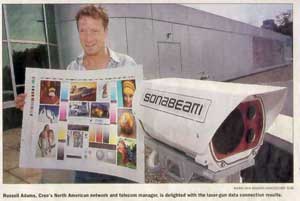 |
|
 |
By Peter Wilson
Originally Published: September 7, 2004
By: The Vancouver Sun

Three-week time frame for linking satellite office to HQ's network
and phones sent company to laser system firm.
The move of
25 telemarketers to an office across the street from the headquarters of Burnaby
tech giant Creo Inc. seems as if it should be an easy matter.
After all, the new office was only 600 metres away, so what could be the problem?
Well, for one thing the 4,200-employee firm needed to
connect those 25 workers at high speed to its own
network and to its phone system. And it had to do this in
three weeks.
Fibre optic cable might have worked -- if Creo didn't have
to spend time to dig up the street at a minimum
estimated cost of $30,000.
That cost was certainly out of line with the fact that the Creo telemarketers would be in the
neighbouring Prime Mover Controls (PMC) building for just two years.
Another option looked at and discarded was two T1 lines with a separate PBX switchboard. But
this wouldn't provide the capacity needed.
However, Creo's North American network and telecom manager Russell Adams came up with
another idea.
He'd heard about Richmond-based fSONA's SONAbeam free space optics (FSO) technology --
which uses precisely aligned laser guns to provide a high-speed data connection.
Like fibre, FSO uses lasers to transmit data in ranges from 100 megabits per second to 2.5
gigabits per second, but instead of enclosing the data stream in a glass fibre, it's transmitted
through the air.
Russell knew that SONAbeam technology had been in place at another Burnaby tech firm just
down the road.
"Electronic Arts was using it," said Adams. "They did not have fibre optic lines to their facilities
for quite a while. They'd utilized that technology, so it was proven."
So Adams called in fSONA and installers Lasercomm. They installed a system at about a 10th of
the cost of fibre optics.
"Long-story-short is that we had the fSONA laser installed on the top of the PMC building as
well as the top of our own building," said Adams. "And we're running our network traffic as well
as our phone traffic over that link."
The installation, which runs at 100 megabits per second, took less than a week, said Adams,
and most of that time was spent on putting in the mounts for the fSONA devices.
A particularly innovative feature of the installation is that the phone system uses voice over
Internet Protocol (VoIP) technology from Nortel rather than requiring a separate PBX in the
satellite office.
Fsona's senior vice-president of marketing Michael Corcoran said that the SONAbeam technology
is particularly suited to VoIP because it offers clean bandwidth with no delay, or latency.
By contrast, he said, 802.11-based wireless technologies, even the 801.16 variety, usually called
WiMAX, couldn't deliver the quality that VoIP requires.
"It's typically fine for data, because data is very forgiving in a TCP/IP environment, but voice is
not," said Corcoran.
Adams said that he's monitoring the usage of the new fSONA system and that the traffic isn't
even touching the limits of what it could handle.
"I would absolutely recommend it to any other company," said Adams. "And within our own
organization I would see it as a disaster recovery plan."
Adams said that if Creo lost fibre optics connections between its facilities on its Burnaby
campus then he could foresee fSONA's technology as the way to reconnect temporarily at high
speed.
Lasercomm's Robert Lanz said that the fSONA technology works well in disaster recovery
because of its mobility.
"You can pack it up and take it with you to the next location because it's so quick to deploy,"
said Lanz.
Adams said that he was unworried about security because it was unlikely anyone could get into
line of sight of the system with the proper equipment to intercept information.
INDY CARS GET FSONA SPEED SOLUTION:
When the cars of the Indy Racing League take to the oval track around North America from now
on -- including the world famous Indy 500 -- they'll be using fSONA technology to speed
information from the timing and scoring tower to the pits.
The SONAbeam 155-E, has been chosen to provide the Indy League (not connected with the
Molson Indy in Vancouver) with a last mile solution.
Data is transmitted from the tower to the pit cart, so that crews will always have the latest
information during pre-race qualification, practice sessions and on race day.
The SONAbeam technology will even be going to Japan for the Indy Japan 500.
networks@png.canwest.com
© The Vancouver Sun 2004
|
 |















